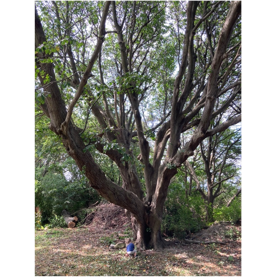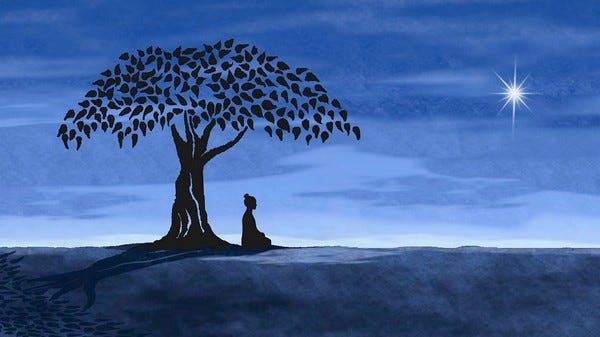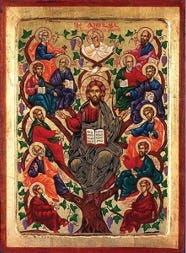“Nobody can know what the ultimate things are. We must, therefore, take them as we experience them. And if such experience helps to make life healthier, more beautiful, more complete, and more satisfactory to yourself and to those you love, you may safely say: This was the grace of God." CG Jung Psychology & Religion 1937
Opportunities abound for hikes near my home in Rhode Island. Years ago, someone had the good sense to set aside land in the form of various conservation efforts. So last week, on a frigid day, I made a tour of the Trustom Wildlife Refuge. In the middle of that trail stands a large white oak tree. A part of my solo hikes always includes a time with that tree, thanks to a convenient bench nearby. I've had many conversations with this grandfather. (I know. The tree does not have gender the way we think of gender, but this is my projection. If you visit, feel free to reference the tree as you wish.) The wonderful thing about talking to a tree is the lack of interruption. He’s a good listener. This giant oak is also willing to have young people climb and play on its branches.
I imagine this tree could tell many stories and has heard the longings, prayers, and dreams of many a sojourner. I’m not alone. During my recent walk and meditation, a thought or voice burst into my mind while sitting in silence by my friend. “Take off your shoes, for the ground you walk on is holy ground.” Those are words YAHWEH spoke to Moses as he approached the burning bush. While reluctant to take off my shoes in 20-degree weather, I got the message. This is sacred land, a holy place, and YAHWEH spoke to me. Maybe not from the freezing bush, but I heard the voice.
“The creative urge lives and grows [us] like a tree in the earth from which it draws its nourishment. We would do well, therefore, to think of the creative process as a living thing implanted in the human psyche.” CG Jung, Spirit in Man, Art and Literature
As late modern inheritors of the materialist worldview, we seem reluctant to openly share our experiences of the sacred in 21st-century western civilization. Yet, as one who chooses to venture out and risk a little embarrassment, I'm finding more and more people have had their encounters with the Holy. But they’ve not shared them with anyone. Many of those encounters occur in nature, and trees seem to be a dominant theme.
Belden Lane describes his enchanting relationship with an old Cottonwood situated in the town park near his home in Missouri. He has even slept in its branches one evening despite discouragement from local officials. Lane describes the beauty and joy of a tree-like mysticism in his thoughtful book The Great Conversation: Nature and the Care of the Soul. While our culture conceives of nature as a product to be utilized for material benefit, Lane makes the case that trees, and indeed all of nature, contribute to soul-making. His retelling of this ancient Taoist story from Chuang Tzu, a fourth-century BCE Taoist sage, provides fresh insight.
One spring, as peach blossoms filled the valley below with a spray of white fragrance, an ancient sage wandered the heights of Shang. He noticed a massive tree on a hillside where all other trees had been chopped down. The others had been cut to build a palace for the emperor. This remaining tree was so enormous that it could shelter the horses drawing a hundred chariots under its shade. It was amazing that it had never been felled. He marveled at how much timber it must contain.
But as he looked up into its branches, he noticed how they were all twisted and crooked, growing in every direction. None were straight enough to be cut into rafters or beams. He broke off a twig and tasted the sap, finding it bitter. The tree would be useless for tapping, producing no syrup of any worth. The leaves, as he crumpled them, gave off an offensive odor. They broke too quickly to be woven into mats or braided into baskets. They wouldn’t even make good mulch. The roots, moreover, were so gnarled that you’d never be able to carve a bowl or fashion a fine decorative box out of them.
"This indeed," said Chuang Tzu, "is a tree good for nothing! That's why it has reached such a great old age. The cinnamon tree can be eaten, so it is cut down. The varnish tree is useful and, therefore, incisions are made in it. We all know the advantage of being useful, but only this tree knows the advantage of being useless!”
The Taoist master sat under the great tree's shade for the rest of the day as a light wind drifted up from the valley below. He breathed the scent of distant peach blossoms and sat in studied silence, contemplating his uselessness. Then, finally, he stopped making judgments about the tree's worth its market value. He sat instead in its welcoming shadow, realizing that his worth had nothing to do with what he was able to produce.[1]
The tree is a powerful image in the world's religions. The tree in the Garden of Eden is a source of knowledge. Jesus' crucifixion is depicted in ancient icons on a tree. He also describes himself as the vine and the branches in John's gospel. The Buddha sat beneath the Bodhi Tree, where he attained enlightenment. In his vision of paradise, Muhammad noticed a great plum tree on the outskirts of heaven. The ancient Celts, that tribe delightful Irish faithful of the land, regarded the oak, the willow, the ash, and the holly as sacred.
In 1990, the Thai Buddhist monk Pharkru Pitak began ordaining trees. (See the video and story here) While witnessing with despair the deforestation, soil erosion, and subsequent break up of families, Pitak began wrapping trees in saffron robes, ritually investing them with the status of a Buddhist monk. Due to the honor given to Buddhist monks in Thai culture, cutting down one of these ordained trees was equivalent to killing a monk. The resulting karmic impact caused a behavior shift as people chose not to cut down the trees and not to allow others to do so. "The sacred values conveyed by the saffron robe had trumped the monetary value of the timber for the market." Writes Larry Rasmussen in his book Earth-Honoring Faith.
As Psalmist sings about the blessed one,
That person is like a tree planted by streams of water,
which yields its fruit in season
and whose leaf does not wither—
whatever they do prospers. (Psalm 1:3 NIV)
Trees recur in my life again and again. As a teenager hiking in the Los Padres National Forest mountains, I learned that to get the water, it needs, the towering Ponderosa Pine would extend its taproot deep into the earth, down as far as six feet and a lateral root system over 100 feet. They can only grow in the arid western climate with an extensive root system. Later in my return to New England, I discovered the majestic-looking birches in their vast groves and interconnected root system. “One could do worse than be a swinger of birches.” (Birches The Poetry of Robert Frost, 1969.)
Carl Jung compared the human soul to a tree with its branches reaching high and its roots diving deep. But I’m wondering if this tree metaphor for our human development doesn’t go far enough. Maybe the trees around us are connected to our souls in some inexplicable way.
Maybe Tolkien had it right, and the trees are alive. Ah, what we could discover on a stop for a conversation.
So yes, I am a lover of trees - the white oak, the birch, the Ponderosa, the Bodhi Tree, and the Christ Tree. I am a tree hugger because when I walk in their midst, I walk on holy ground.
[1] Adapted by Belden Lane from James Legge The Texts of Taoism (Oxford: Oxford University Press, 1891), book 4, number 7. This version appears in The Great Conversation Belden Lane, Oxford University Press, page 96







Wonderful insights